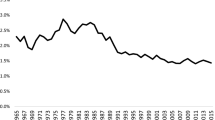Abstract
Earlier studies have explained inter-country variations in the share of GNP devoted to military expenditures by international spillovers and by differences in the threat of attack related to relative incomes. In this paper, we use the theory of public choice to explain these differences. We attempt to measure the importance of both international spillovers and relative incomes, along with two other factors: the tax-price elasticity of demand and economies of scale in the consumption of security.
We find that international spillovers are significant and positive, that the income elasticity of demand is greater than unity, that the tax-price elasticity of demand explains part of observed inter-country differences, and that there are considerable economies of scale in the consumption of military spending. Finally, between 1960 and 1975, there was apparently a substantial increase in the value which each country derived from a dollar of military spending by its allies. This phenomenon, which seems related to the increased importance of deterrent weapons, has tended to induce individual alliance members to reduce the share of their national income devoted to defense.
Similar content being viewed by others
References
Bergstrom, T.C. and Goodman, R.P. (1973) Private Demands for Public Goods American Economic Review, 63: 280–296.
Borcherding, T.E. and Deacon, R.T. (1972) The Demand for the Services of Non-Federal Governments. American Economic Review, 62: 891–901.
Bowen, H.R. (1943) The Interpretation of Voting in the Allocation of Economic Resources. Quarterly Journal of Economics, 58: 27–48.
Deacon, R.T. (1977) Private Choice and Collective Outcomes: Evidence from Public Sector Demand Analysis. National Tax Journal, 30: 371–386.
Dudley, L. and Montmarquette, C. (1979) The Demand for Quasi-Public Goods: Income and Price Elasticities. Université de Montréal, unpublished manuscript.
Filimon, R. (1979) Aggregation and the Median Voter. Carnegie-Mellon University, Pittsburgh, unpublished paper.
Fletcher, R. and Powell, M.J.D. (1963) A Rapidly Convergent Descent Method for Minimization. Computer Journal, 6: 163–168.
Gillespie, W.I. (1976) On the Redistribution of Income in Canada. Canadian Tax Journal, 24: 417–450.
Goldberger, A.S., Nagar, A.L., and Odeh, H.S. (1961) The Covariance Matrices of Reduced-Form Coefficients and of Forecosts for a Structural Econometric Model. Econometrica, 29: 556–573.
Hotelling, H. (1929) Stability in Competition. Economic Journal, 39: 41–57.
Katzner, D.W. (1968) A note on the Differentiability of Consumer Demand Functions. Econometrica, 36: 415–418.
Kissinger, H. (1979) White House Years. Boston: Little Brown.
Musgrave, R.A., Case, K.E., and Leonard, H. (1974) Distribution of Fiscal Burdens and Benefits. Public Finance Quarterly, 2: 259–312.
Olson, M. and Zeckhauser, R. (1966) An Economic Theory of Alliances. Review of Economics and Statistics, 48: 266–279.
Romer, T. and Rosenthal, H. (1978) Political Resource Allocation Controlled Agendas, and the Status Quo. Public Choice, 33: 27–44.
— and — (1979) The Elusive Median Voter. Journal of Public Economics, 12(2): 143–170.
Sandler, T. (1977) Impurity of Defense: An Application to the Economics of Alliances. Kyklos, 30: 443–460.
Thompson, E.A. (1979) An Economic Basis for the National Defense Argument for Aiding Certain Industries. Journal of Political Economy, 87: 1–36.
Author information
Authors and Affiliations
Additional information
We wish to thank Professor Marcel G. Dagenais for his suggestions in dealing with the simultaneity problem encountered with our model. We are also grateful to Thomas Borcherding and the participants in the Carnegie Conference on Political Economy for their comments. Denis Bolduc and Paul Forest made significant contributions as research assistants. Benoit Lyrette and Claude Dallaire were helpful at an earlier stage of the work. This research was financed by the Centre de Recherche en Developpement Économique of the Université de Montréal and by the Social Sciences and Humanities Research Council of Canada. Any remaining errors are our responsibility.
Rights and permissions
About this article
Cite this article
Dudley, L., Montmarquette, C. The demand for military expenditures: An international comparison. Public Choice 37, 5–31 (1981). https://doi.org/10.1007/BF00124229
Issue Date:
DOI: https://doi.org/10.1007/BF00124229




